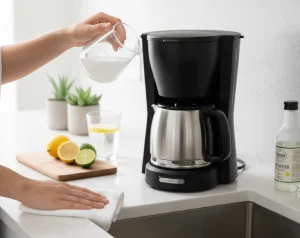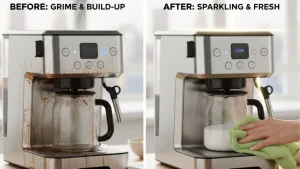How to clean coffee maker is something I realized I needed to know the morning my coffee tasted a little off. My trusted brewing companion suddenly seemed less reliable. Like many of us, I depend on this countertop device to deliver a perfect cup every day. Over time, minerals in tap water—things like calcium and magnesium—can slowly build up inside, affecting flavor, brew time, and overall performance. Fortunately, keeping everything in top condition doesn’t take much. With some simple steps, a few minutes, and everyday supplies, I can ensure every cup tastes as fresh as the first one. I’ll walk you through my routine for keeping my coffee setup clean, efficient, and dependable.

Here’s what I cover:
-
Why regular upkeep matters
-
My go-to supplies
-
Daily upkeep tips
-
Weekly deeper cleaning
-
How I remove mineral deposits
-
Signs it’s time for a more thorough clean
-
Preventing buildup before it starts
-
Common mistakes to avoid
-
Extra tips for better coffee
-
FAQs
Why Routine Upkeep Matters
I’ve learned that skipping even a few cleaning sessions can change how my brew tastes. Residue from oils, splashes, and leftover grounds can leave coffee bitter or flat. Over time, minerals from water can clog internal parts, slowing down the process.
Maintaining your coffee setup isn’t just about taste. It helps the appliance last longer and keeps every pot brewing consistently. If I want smooth, flavorful coffee morning after morning, staying on top of cleaning is essential.
My Go-To Supplies
Keeping things simple is key. Here’s what I use to keep my setup in top shape:
Cleaning Essentials:
-
Mild dish soap
-
White vinegar or specialized cleaning tablets
-
Filtered water for rinsing
Helpful Tools:
-
Soft cloth or sponge
-
Dishwasher (for removable parts)
Having these ready means I never scramble when I notice a bit of buildup or coffee splashes.
How to Clean Coffee Maker: My Daily Upkeep Routine:
-
Wipe Down the Exterior – Use a damp cloth to clean the outer surface and showerhead. This removes small spills and keeps your appliance looking neat. Avoid immersing the whole machine in water.
-
Quick Rinse for Removable Parts – Rinse the carafe, lid, filter basket, and reusable filter after each use to prevent leftover oils from sticking and to keep every cup tasting fresh.
-
Leave Compartments Open to Dry – Keep the lid and basket open to allow air circulation. This helps reduce moisture and prevents bacteria growth inside your coffee maker.
How to Clean Coffee Maker: My Weekly Deep Cleaning Routine:
Once a week, I take a closer look at everything:
-
Hand-Wash Removable Pieces – I use warm, soapy water for the carafe, lid, filter basket, and reservoir.
-
Dishwasher Check – If the parts are safe for the dishwasher, I place them on the top rack for a more thorough clean. It saves time and ensures every corner is spotless.
-
Inspect Internal Components – I check the showerhead and interior for buildup, wiping them down when necessary.

Removing Mineral Deposits
Mineral buildup is what really affects flavor and efficiency. I tackle it about once a month, depending on my usage and the hardness of my water.
Method 1: Vinegar Solution
-
Remove all filters and coffee grounds.
-
Fill the reservoir halfway with white vinegar and halfway with water.
-
Run a full brewing cycle.
-
Empty the carafe and run 2–3 cycles with fresh water to rinse thoroughly.
-
Wash the carafe and basket in hot, soapy water.
The acidity in vinegar helps break down deposits safely and effectively.
Method 2: Cleaning Tablets
Sometimes I use affresh® coffee cleaning tablets instead. I follow the instructions for mixing with water and running a full cycle. If the tablet doesn’t fit in the reservoir, I crush it into smaller pieces first.
Signs Your Coffee Setup Needs Extra Attention
I’ve learned to watch for these indicators:
-
Cleaning light turns on (if available on your model)
-
Longer brewing time than usual
-
Unusual gurgling or noises
-
White residue on visible parts
-
Slightly off taste in coffee
When any of these appear, it’s time for a more thorough clean. Waiting too long can impact flavor and shorten the appliance’s life.
Preventing Buildup Before It Starts
A few small habits make a big difference:
-
Filtered Water – I rely on filters to reduce dissolved minerals. It keeps coffee tasting clean and protects internal parts.
-
Daily Rinse – Quick rinses stop coffee oils and residues from sticking.
-
Proper Drying – Leaving compartments open to air dry prevents moisture from collecting inside.
Tip: Avoid distilled water in certain models, including KitchenAid® coffee makers. Its chemical makeup can attract metal ions and gradually damage internal components.
Common Mistakes I Avoid
-
Submerging the machine in water.
-
Skipping daily wipe-downs.
-
Forgetting to rinse after descaling.
-
Ignoring cleaning indicators.
Consistent attention keeps the brew tasting great and the appliance lasting longer.
Extra Tips for the Best Cup
-
Rotate Water Filters – Replace as recommended.
-
Check Coffee Grounds – Too fine or oily grounds leave more residue.
-
Monthly Descaling – Even if buildup isn’t obvious.
-
Set a Weekly Reminder – A consistent routine keeps cleaning from being forgotten.
For more tips, check out my guide on making the perfect coffee at home.
FAQ
Q1: Can I use bleach to clean my coffee gear?
A1: No, it can damage the appliance and affect taste. Stick to vinegar or specialized tablets.
Q2: How often should I clean my setup?
A2: Rinse removable parts daily, deep clean weekly, and descale about once a month.
Q3: Is all vinegar safe for descaling?
A3: Use plain white distilled vinegar. Avoid flavored or colored versions.
Q4: Are vinegar cycles safe for all coffee devices?
A4: Most can handle it, but check the manual. Some models have pre-programmed cleaning cycles for convenience.
Q5: How can I avoid bitter coffee from mineral buildup?
A5: Filter water, rinse parts daily, and follow a monthly descaling schedule.
Final Thoughts
How to clean coffee maker properly doesn’t need to be complicated. A quick daily rinse, weekly cleaning, and occasional descaling are all it takes to keep your appliance running smoothly for years. With just a few minutes and simple supplies, you can enjoy a consistently fresh cup every morning.